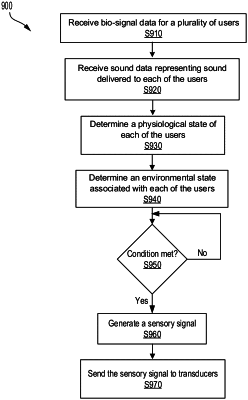| CPC A61B 5/38 (2021.01) [A61B 5/165 (2013.01); A61B 5/316 (2021.01); A61B 5/375 (2021.01); A61B 5/486 (2013.01); A61B 5/742 (2013.01); A61M 21/00 (2013.01); A61M 2021/0027 (2013.01); A61M 2205/3375 (2013.01); A61M 2205/3561 (2013.01); A61M 2205/3584 (2013.01); A61M 2205/502 (2013.01); A61M 2205/52 (2013.01); A61M 2230/06 (2013.01); A61M 2230/10 (2013.01); A61M 2230/42 (2013.01); A61M 2230/60 (2013.01); A61M 2230/65 (2013.01)] | 11 Claims |

|
1. A computer-implemented method for sharing a user experience, comprising:
receiving bio-signal data for a plurality of users from a plurality of bio-signal sensors;
receiving sound data representing sound experienced by each of the users;
determining a physiological state of each of the users based at least in part on the bio-signal data of that user;
determining an environmental state associated with each of the users based at least in part on the sound data;
using a rules engine, determining if a condition is met, based at least in part on the physiological state of each of the users and the environmental state associated with each user;
upon the condition being met, executing an associated action including generating a sensory signal; and
using transducers, outputting a sensory output to each of the users based on the sensory signal.
|